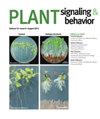草酸分解代谢中保守的草酸辅酶A脱羧酶
IF 2.8
4区 生物学
Q3 BIOCHEMISTRY & MOLECULAR BIOLOGY
引用次数: 0
摘要
草酸的生物合成能力可以为植物提供有益的功能;然而,不受控制或长时间暴露于这种强有机酸会导致多种生理问题。这些问题包括膜完整性、线粒体功能、金属螯合和自由基形成的破坏。最近的研究表明,依赖于辅酶a的草酸分解代谢途径在调节植物组织草酸浓度中起着关键作用。虽然这种依赖于辅酶a的草酸分解代谢途径是重要的,但我们对催化每一步的酶的知识仍然存在很大的差距。有证据表明,草酰辅酶a脱羧酶(OXC)催化了该途径的第二步,加速了草酰辅酶a向甲酰基辅酶a的转化。诱导研究表明,OXC基因表达上调,以响应外源草酸供应。系统发育分析表明,oxc在植物物种中是保守的。在进化上,植物的氧合细胞可分为双子叶和单子叶两类。多个序列比对和分子模型表明,OXCs具有相似的三个保守结构域,即n端PYR结构域、中间R结构域和c端PP结构域。进一步研究这种依赖于辅酶a的草酸降解途径,将有助于制定提高作物营养品质的新策略。本文章由计算机程序翻译,如有差异,请以英文原文为准。
A conserved oxalyl-coenzyme A decarboxylase in oxalate catabolism
ABSTRACT The ability to biosynthesize oxalic acid can provide beneficial functions to plants; however, uncontrolled or prolonged exposure to this strong organic acid results in multiple physiological problems. Such problems include a disruption of membrane integrity, mitochondrial function, metal chelation, and free radical formation. Recent work suggests that a CoA-dependent pathway of oxalate catabolism plays a critical role in regulating tissue oxalate concentrations in plants. Although this CoA-dependent pathway of oxalate catabolism is important, large gaps in our knowledge of the enzymes catalyzing each step remain. Evidence that an oxalyl-CoA decarboxylase (OXC) catalyzes the second step in this pathway, accelerating the conversion of oxalyl-CoA to formyl-CoA, has been reported. Induction studies revealed that OXC gene expression was upregulated in response to an exogenous oxalate supply. Phylogenetic analysis indicates that OXCs are conserved across plant species. Evolutionarily the plant OXCs can be separated into dicot and monocot classes. Multiple sequence alignments and molecular modeling suggest that OXCs have similar functionality with three conserved domains, the N-terminal PYR domain, the middle R domain, and the C-terminal PP domain. Further study of this CoA-dependent pathway of oxalate degradation would benefit efforts to develop new strategies to improve the nutrition quality of crops.
求助全文
通过发布文献求助,成功后即可免费获取论文全文。
去求助
来源期刊

Plant Signaling & Behavior
Agricultural and Biological Sciences-Plant Science
CiteScore
6.00
自引率
3.40%
发文量
111
期刊介绍:
Plant Signaling & Behavior, a multidisciplinary peer-reviewed journal published monthly online, publishes original research articles and reviews covering the latest aspects of signal perception and transduction, integrative plant physiology, and information acquisition and processing.
 求助内容:
求助内容: 应助结果提醒方式:
应助结果提醒方式:


